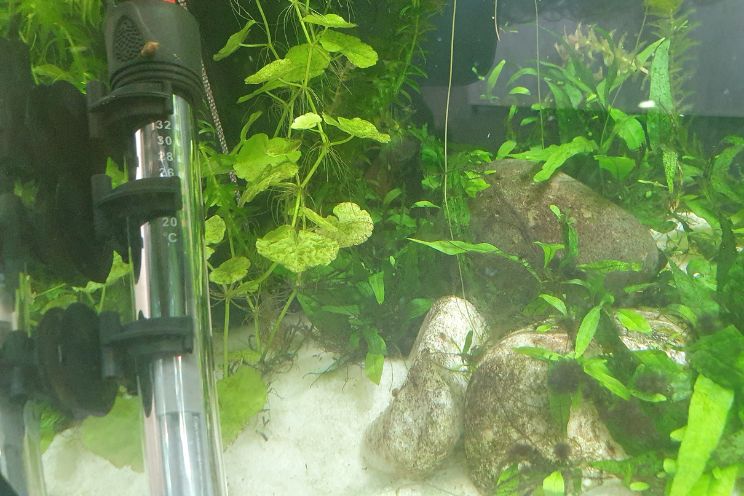During winter when the cold months arrive, it can become dangerously cold for your aquarium fish, especially tropicals.
You may experience snow storms, power outages and severe dips in temperature that go far below the comfortable range.
So how do you maintain a temperature above 20C / 68F with and without electricity?

How do aquarium heaters work?
Glass aquarium heaters are simple yet ingenious – they consist of a glass rod, containing metal coils which heat up. The glass also contains a thermostat, which can be set to a certain temperature that it will maintain.
To use a glass heater, follow these steps:
- Turn the dial on the top to the temperature you want. It will usually show on the side or on top what temperature it is already set to.
- Place the heater in your tank, having it at a 45 degree angle, either hanging or stuck to the glass with some clips and suction cups (these usually come with the heater.)
- Once submerged, leave the heater without plugging it in to adjust to the temperature of the tank for 40 minutes.
- After this, turn on the heater and it will bring the temperature of the tank up to the preset.
- The coils inside the glass will radiate heat over a period of time to warm the surrounding water, much like a radiator. It will do this slowly as a way to prevent your fish from cooking themselves, but it can still be very warm to touch sometimes, so be careful if handling it.
- It may take a couple hours to a day before the heater does its work, but once it has reached its temperature, it will maintain it well. If ever the tank temperature drops below the set margin by 2 or 3 degrees, the heater will turn on until the temperature is brought back up.
Does the size of the aquarium heater matter?
In a way yes, the size of the heater does matter, but it is more the wattage you are looking at for a measurement of heating output.
You need to acquire a heater that has a wattage similar in number, to the amount of litres your tank holds, for example:
A 50 litre tank will need a heater that is 50 watts. A 300 litre tank will need a 300 watt heater.
This is fairly straightforward, however, most heaters only go up to 300. So, what do you do if your tank holds more than 300 litres?
Surprisingly, a 300 watt heater can warm up a lot more than people think. From our experience, we’ve heated a 1000 litre tank with a single 300 watt heater!
However, this isn’t the same for everyone and some tanks may need extra heating to stay warm due to their location, filtration and many other factors which can cause them to lose heat more easily.
What we would recommend for those large tanks is to install multiple heaters, have maybe 2 or 3 300 watt heaters all working together and set to the same temperature.
Or instead of a glass heater, you could use a titanium heater.

What are titanium aquarium heaters?
Titanium heaters are very similar to glass heaters, but they are for heavy duty temperature control.
They are similar in that they come in the form of a rod, which works like an aquatic radiator.
The heater works in much the same way, with a few subtle differences which can make it ideal for those more specialist larger setups.
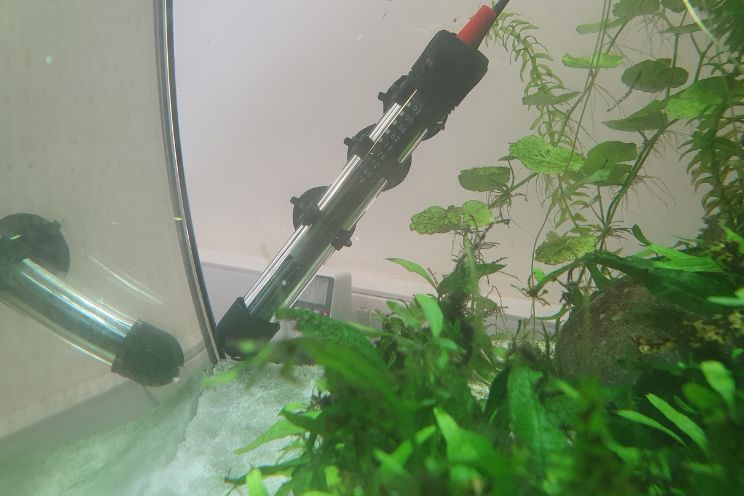
Glass heater vs titanium heater
These heaters do have some slight differences, one of these being the material they are made from – titanium.
Titanium is far better at expelling heat than glass because it does not stress as easily, so it can put up with more stress from temperature fluctuations. It is also resistant to saltwater, which is why they are used so often in marine setups.
Titanium heaters are extremely fast and efficient at heating an aquarium and will do so much much faster than a glass heater. They do however, lack a thermostat like their glass cousin and so need one separate to control the temperature and prevent the cooking of your fish.
Titanium heaters are also less resistant to burning out, breaking and of course shattering, because the metal can be put under more stress than glass. While they may sound like just a better glass heater, the things that set titanium heaters apart make them ideal only for certain setups.
We usually do not recommend titanium heaters for typical setups for a few reasons – they are mainly ideal for those larger marine tanks with huge sumps and filtration units.
They are very high tech and so dont need to be installed to your 10 gallon planted tank, although it is entirely possible to do, it is unnecessary.
As mentioned, titanium heaters are very powerful and reach their desired temperatures comparatively quickly. This means they become very hot to the touch, so be very careful when handling them and make sure they are switched off.
The fact they lack a thermostat also makes them ideal only for certain setups, since an additional piece of equipment is needed to regulate the temperature, which is better used in a sump filter.
Titanium heaters are also very expensive and could cost you more than everything else in your setup combined if you have a small tank! They also consume much more electricity than a glass heater.
Once you have a titanium heater however, you will have it for many years, as they are very well constructed and resistant to breakage, unlike the glass heater which can shatter if the glass becomes stressed.
However, after the costs, heat output and additional setup requirements, we much prefer the more simplistic and cost effective glass heater for smaller tropical or temperate tanks; they do the job just fine for most people.

Do I need a heater for my fish tank over winter?
For tropical fish, you should have a heater, especially over winter when things get cold.
At any point in the year, if your tank gets below the optimal temperature for the fish you are keeping, then you need to consider purchasing a heater to control it.
Even if it’s not on all the time, it will prevent sudden sharp temperature drops and keep your fish safe.
For some people, having a heater is more of a preventative measure, but it is still valuable to have just in case.
These sharp temperature drops at night time are more prevalent in winter, even inside your home and dropping below 18C / 64F is too much for some fish species.
Why do you have to keep your fish tank warm?
Being able to control the temperature of your tank is vital to running a successful fish tank, as the temperature controls the fish’s lives.
Their digestion, energy use, lifespan and behaviour is all decided by the temperature, and if you want your pets to live a healthy normal life, you need to be keeping them at the correct temperatures, whether that means having a heater or not.
Goldfish do not require a heater, as they are coldwater fish. They will live perfectly fine at room temperature, although a heater can sometimes be used to help with digestion, fight off disease and speed up growth.
Tropical fish need to stay at temperatures similar to those of their natural habitat, this is usually slightly higher than room temperature and so an aquarium heater is needed to maintain this tropical heat.
Failure to keep the tank at the right temperature can cause illness, lethargy, malnutrition, organ failure and eventual death in fish that can’t cope with cold temperatures.
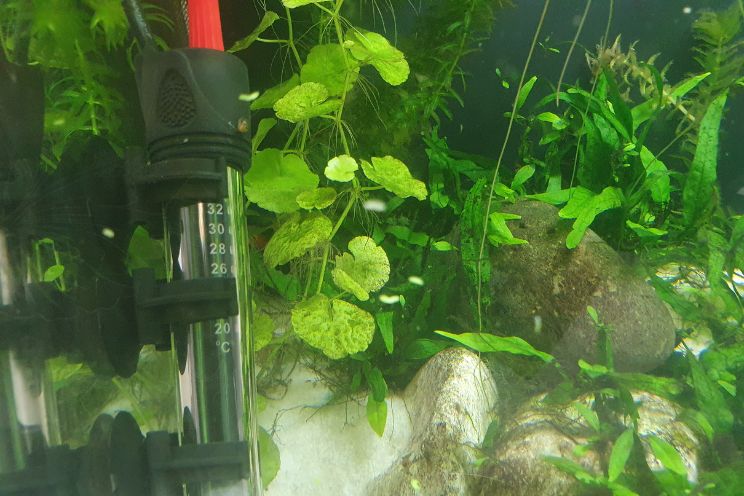
Can fish survive without a heater?
As previously mentioned, different fish have different temperature requirements, and some can tolerate certain temperature ranges that others can’t.
It is heavily dependent on the fish and the scenario it is in whether or not it can survive without a heater.
If you have good experience in fishkeeping, the species you are keeping can tolerate temperature drops, and the environment is stable, then your fish may not always need a heater.
We still always recommend you have one just in case as it allows you to control their metabolism which makes feeding and care easier.
In the wild, many tropical fish can survive drops by as much as 10 degrees at night time, but this doesn’t mean that they should experience this, and being your pet, you should not expose them to such extreme conditions.
In short, if you are asking this question, then we would tell you to get a heater.
What happens if your aquarium temperature is too low?
If your aquarium becomes too cold, then your fish will begin to slow down in activity and depending on the species, this can affect them differently.
For temperate and cold water species, they can put up with a wide range of temperature drops and will be largely unaffected, other than having their metabolic rate slowed down.
For tropical fish, with a more limited tolerable temperature range, they can enter an emergency state of torpor and can become vulnerable to disease and organ failure after a prolonged time.
Most fish will be okay with large temperature drops for a number of hours, but keeping something like a discus (which lives in temperatures of up to 32C / 90F) and dropping it below 10C / 50F for 6 hours will more than likely kill it or at least cause it extreme stress and illness.
In short, different fish are affected differently.
That said, all fish will be affected negatively by a quick and steep drop in temperature, regardless of the species.
- Maintaining a stable temperature is key.

What is the ideal temperature for a fish tank?
Fish are found all over the world in all different types of environments, from the Arctic to Africa, some can live in sub zero waters, whereas others live on volcanic islands and desert pools.
Depending on the species and where it is found in the world will decide what temperature it feels most comfortable at.
However, most fish in the aquarium hobby are from South America, which has an average annual temperature range of 26C – 22C / 78F – 70F.
It very seldom gets below 15C / 59F in south america and so we keep most tropical fish at around 25C / 77F.
Coldwater fish like goldfish are best kept at anywhere from 18C – 24C / 64F – 75F.
Tropical fish from Africa and East Asia also prefer similar temperatures to South American and do best at around 24C, but this can again vary between species. Some West African fish prefer warmer temperatures, whereas Central Africans have slightly cooler temps, depending on where the fish are collected from.
It is best to do your research first on each fish to find out where it lives and what the best temperatures are for that area.
How cold is too cold for a fish tank?
Too cold is when the temperature drops outside of the range which your fish are able to cope with – for goldfish, this would be anywhere less than 10C / 50F in an aquarium (in a pond, this temperature can go much lower.)
For most tropical fish, this is below 21C / 78F and for tropical marines and reefs this is below 24C / 76F.
Dropping below these temperatures can cause stress and ill health in your fish / other aquarium inhabitants.

How to maintain the ideal temperature in a fish tank
The best way to maintain heat is to leave your aquarium heater set to the correct temperature in your tank, and have it plugged in at all times.
While you may be concerned it could overheat or that it consumes lots of electricity, don’t worry, it doesn’t.
Nearly all glass aquarium heaters these days have built-in thermostats which will automatically turn off the heater once it reaches the right temperature, saving electricity and preventing the tank from overheating.
Other methods are to use heat mats, lamps or ceramic heaters, although for an aquarium, these have varying levels of access and safety, just make sure to install an appropriate thermostat if you use these.
Make sure the lamps and plugs do not get water on them, as they can burn out or spark.
Another method many people use is to just heat the room. If you have many aquariums, this is the most cost effective way to keep the tanks warm. Have a heater in the room set to 24C and allow it to run.
Using techniques to insulate the room and the aquariums is also good for saving power and expenditure on heating.
How can I keep my tank warm without a heater?
There are a number of ways to heat a fish tank, like using the aforementioned equipment like heat mats, ceramic lamps, etc. But what about other means without the use of electricity?
Aside from heating the room, there aren’t many ways to warm up your tank safely without the use of electrical equipment.
But there are certainly ways to insulate your tank and better trap heat, meaning that you don’t have to expend as much energy and resources keeping the tanks warm.
Using polystyrene is a very old technique used by fish keepers many years ago to keep the heat in the tanks.
Having a thick insulating layer of polystyrene behind or on the sides of the tank ensures heat stays in the tank and can hold the heat for many months if set up properly.
Using plastic or glass lids also greatly reduces the amount of heat loss, or even towels!

Are fish sensitive to temperature changes?
Every fish species has evolved to suit its own environment – this means they are accustomed to living in the specific habitat they have been surviving in for the past few million years.
For example, Platies are found in Southern Mexico, Central America and some parts of Northern South America.
Here the waters are warm, high in minerals and high in oxygen. They are also slightly brackish with some level of seawater entering the streams, swamps and river deltas they are found in.
As a result of this, Platies cannot survive well in cold, soft water with no minerals and low oxygen and they can die if kept in cold acidic waters for too long.
However, this can have some leeway and the parameters don’t have to match those exactly to their natural habitat.
Additionally, fish that have been bred in captivity, will be better adapted for swings in water parameters and are generally better suited to aquarium life than their wild parents.
Platies nowadays are much hardier and adapted to aquarium life than they used to be when they were first collected, and this is partially due to the fact they have been domesticated and bred in aquariums for many years.
Platies have always been considered as hardy and adaptable fish however, and this is largely due to the fact they live in a constantly changing environment, so they are used to environmental swings and changes in temperature.
Typically, fish that are found in larger more stable bodies of water are not as adaptable to large swings in temperature. Fish that are found in large lakes and oceans are usually more sensitive than fish found in rivers, streams and ponds.
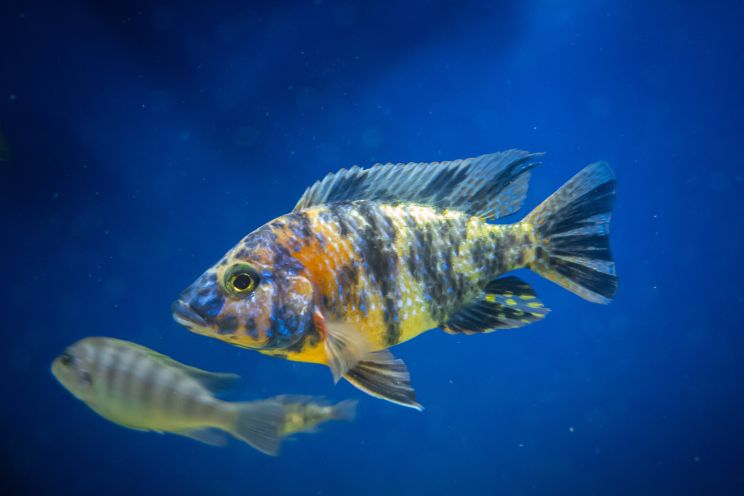
Fish that are sensitive to water temperature fluctuations
The main types of fish that are more sensitive to temperature swings are fish that live in larger bodies of water, those found in huge lakes, colossal rivers and oceans.
Marine fish are by far the most sensitive to temperature change as the ocean is so large; it is supposed to stay near enough the same temperature annually with only minor fluctuations throughout the years.
This is the reason why global warming affects marine life so harshly and why coral reefs are becoming extinct, as they are not adapted to fast rises in temperature, which we are experiencing today all over the world.
All tropical marine fish are like this, as they are mostly found in the same water.
The next most sensitive group are fish found in huge lakes and rivers, although this is the next most sensitive group they are significantly hardier than marine fish, due to the nature of freshwater fish being more adaptable to change.
Here we will list some of the more temperature sensitive freshwater fish found around the world. These fish are found in all different environments but most are from large lakes and rivers:
- Discus
- Angelfish
- Eels
- Stingrays
- South American Cichlids (Oscars, midas, peacock bass)
- Cockatoo Dwarf Cichlids
- Banjo Catfish
- Malawi Cichlids
- Cardinal and Neon Tetras
- Julii Corydoras
- Congo Tetras
- Most other African and South American Tetras
While these fish may not be as well suited to large temperature drops, it does not necessarily mean they are difficult to keep.
But if you want to keep any of these fish, then you should definitely invest in a good aquarium heater, suitable for your tank and have a thermometer to monitor the temperature.

Fish that are resilient to water temperature fluctuations
Fish that are more resistant to temperature change are typically your temperate fish and coldwater fish.
However, there are some tropical fish too that are able to withstand temperature fluctuations too.
These fish typically live in smaller bodies of water that are more subject to change, fast moving rivers or cooler environments:
- Danios
- Rasboras
- Carp and Goldfish
- Loaches
- Paleatus Corydoras
- Rosy Barbs
- Variatus Platies
- Widow Tetras
- Killifish
- Ricefish
- Minnows
- Black Corydoras
- Flag Fish
- Siamese Algae Eaters
- Red Tail Shark
Not all of these fish can live in cold water, but they are much more tolerable to temperature shifts than other fish in the hobby.
While we recommend a heater for some, they may not always need one switched on, especially during summer and can be much more forgiving of mistakes regarding temperature.
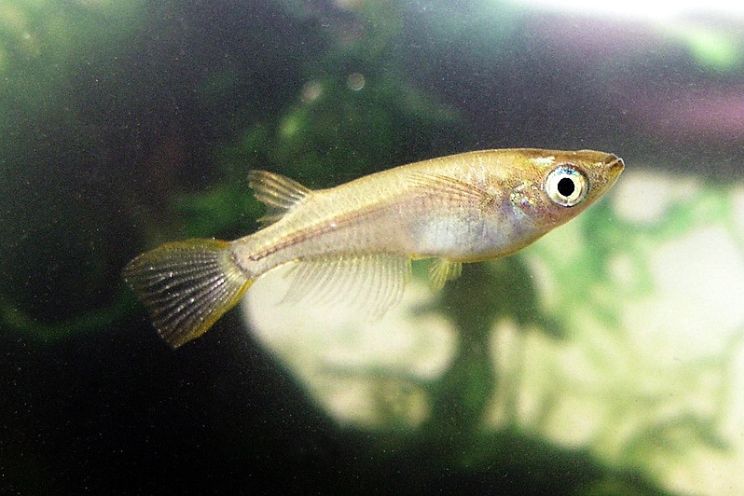
The best aquarium heaters
We stand by glass aquarium heaters for their ease of use, reliability, availability and cost; they are the best all round method of keeping your aquarium warm.
Glass heaters are also usable in nearly all setups, making them highly adaptable as they come in a range of different sizes for different tanks.
Although they have some minor downsides, they are outweighed by the many benefits glass heaters come with.
There are also many brands of aquarium heater and so they have widespread availability, with varying cost and quality.
A personal favourite of ours is interpet.
Interpet deltatherm heaters are an excellent brand of glass heater, we’ve had experience with over the years.
We have used all different brands of heaters and these are one of the best on the market today – they are affordable, easy to use, effective and last a long time.
They are usable under all different setups, saltwater, freshwater, large and small, we’ve even used them to heat ponds!

Tips for keeping your tank warm in cold weather
Keeping your tank warm in winter can be a little more costly than in summer, and you may need to take some additional measures to ensure the safety of your fish.
There are all different techniques for keeping a tank warm. Some are high tech and advanced, whereas some like the mentioned polystyrene insulation are simple, cheap and primitive.
Although some methods have varying levels of cost and effectiveness, they can still work. It is all dependent on the individual scenario and what types of fish you are keeping.
For some people, it is far easier to just heat the room and provide insulation to windows and doors to trap heat, keeping many tanks warm without having hundreds of individual glass heaters plugged in.
For others, it is best to just run glass heaters or titanium heaters on their tank or tanks.
Other people may live in an area where the temperature is tropical all the time, and so need to take little measures to keep the tank warm, other than making sure they are well insulated.
How to keep a fish tank warm in winter
Some key tips we can offer to anyone though are as follows:
- Use a lid on your aquariums, it will trap heat and save water from evaporating.
- Place your tank against a wall or in a corner, which is away from windows or doorways, bedrooms and living rooms are the best spaces for ideal temperature ranges.
- Use the appropriate wattage heater for your tank.
- Use a thermostat if you use a bulb or heat matt and make sure they are waterproof.
- Keep the room warm over winter by having well insulated windows and keeping the doors closed.
- Check your thermometers are accurate.
- You can use polystyrene or towels around the glass to keep the heat inside the tank.
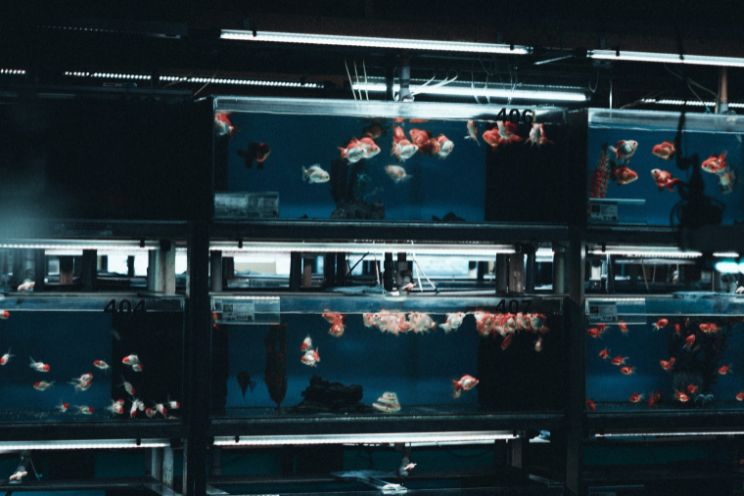
What to do if the power goes out
If you live in an area where harsh winters mean snowstorms and power outages, then don’t worry, your fish can withstand a period of time without heating.
You should first look into the cause of the power outage and find out when you will expect to have power back, while keeping yourself and family safe as well as your fish.
The next thing you need to do when the power goes out is insulate the tanks. Try some of our mentioned methods, like a lid, polystyrene or wrap towels around your tank(s) – even cardboard is a good insulator!
Insulating your tanks can give you some extra time before the tanks come on and is certainly worth doing.
Using a generator or battery to power your heater is also a good idea, if possible.
However, temperature is not the main threat to your fish during this time. You should actually prioritise filtration and oxygenisation.
Once the filtration and oxygen are solved, then worry about bringing the temperature back up.
If you can’t get either solved, sometimes it is better to leave the fish to stay cool, as this will slow down their metabolism and reduce the amount of ammonia production until the power comes back on.
However, depending on the fish you keep and the length of the power outage, the chances of everything surviving cannot be guaranteed.
Sometimes it is unavoidable and you may lose some fish, but what is important is that you try to minimise the impact on the tank as a whole and stay safe.
